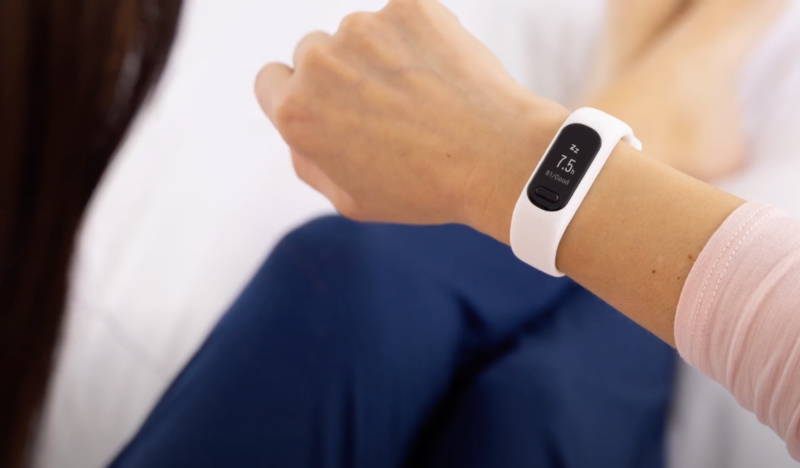
Garmin
Garmin just released its latest fitness tracker, the Vívosmart 5, a wearable that covers the basics of sleep and activity tracking, with phone notifications. It replaces the 4 year old vívosmart 4. But in four years, the new tracker hasn’t changed much from the last version, and rivals like Fitbit’s Charge 5 have made notable leaps.
When Garmin released the Vívosmart 4 in 2018, it had advantages like a blood oxygen sensor that was rare at the time and a typical suite of in-depth health metrics that Garmin outshone most competitors. Fitbit’s comparably priced Charge 5 fitness tracker now also comes with a blood oxygen sensor, as well as a galvanic skin sensor (for stress measurement), GPS, and the ability to take ECG readings — all of which the new Vívosmart 5 lacks.
Before the official release of the Vívosmart 5, I spent a weekend sleeping, exercising, and tracking my physical vitals to get a quick look at the device and see if Garmin’s in-depth data and proprietary metrics were still worth buying. Since it’s a pre-release model, there are some known bugs, but nothing prevents us from getting a clear idea of what it does.
minor physical changes
-
Garmin’s Vívosmart 5 looks a lot like the Vívosmart 4, and that’s because it’s both form and function.
-
It’s a narrow silicone wearable about the width of a watch strap. Below is a traditional strap buckle. The straps are now also interchangeable.
The basic appearance of the Vívosmart 5 is the same as the 4. It’s a slim silicone fitness tracker with a small black and white OLED screen. The straps snap together like a traditional strap, just like its predecessor, only now just pop the tracker and the straps are interchangeable. It looks seamless, and you have to take it off your wrist to get the tracker out.
The screen has grown by 66 percent, but that doesn’t make it any bulkier. Even with the wider screen, it’s still a cramped device. Garmin also integrated a physical home/back button below the screen, which used to be a tactile button. The plastic buttons require an intentional push to press, so in my time with the device, I’ve never pressed a button by mistake.
advertise
The screen animation is smooth and the touch response is good. It’s a small screen, though, about an inch long and half an inch wide. So while menu widgets and text are fine, longer notifications, like emails or texts, require some scrolling. The screen can hold up to eight short words at a time.
activity tracking
The Vívosmart 5 can track heart rate, blood oxygen levels, stress and breathing rate both day and night. Activity tracking has 14 modes, including HIIT, yoga, strength training, breathing, and more. Garmin can also enable menstrual cycle tracking in the companion app.
Activity and sleep tracking data trended close to the readings on my Apple Watch Series 7 and Google Nest Hub’s sleep detection. The Vívosmart’s heart rate data and associated calorie burn were consistent with the Apple Watch’s activity readings, but the deeper analysis that people might normally choose from Garmin devices wasn’t there.
Since it’s a more basic tracker, calories, heart rate, and heart rate zones are the only data you collect from your activity. There’s no built-in GPS, so you’ll have to carry your phone with you if you want to record location data while running or cycling. Also, you won’t analyze your anaerobic and aerobic gains like you would with more powerful Garmin wearables like the Forerunner series.
-
Vívosmart only provides basic activity statistics such as heart rate and calories burned.
-
Graphs allow you to view post-workout heart rate zones and data.
-
The Vívosmart’s metrics are close to the Apple Watch Series 7 results and provide the same amount of data. Most of Garmin’s in-depth analysis and metrics are not used on the Vívosmart 5.
The Vívosmart does have Garmin’s Body Battery metric to help you measure your daily recovery and exercise levels, but it’s not as powerful or as prescriptive as Fitbit’s Daily Readiness. Rather than simply charting a 0 to 100 percent score like Garmin does, Fitbit also recommends a specific workout each day, depending on whether it thinks you need to focus on high-intensity, moderate, or recovery-focused activities.
Fitbit, though, charges $10 a month for this and other data and content on its Fitbit Premium subscription plan — a subscription that Garmin says it won’t replicate, as a growing number of wearable makers say model.










